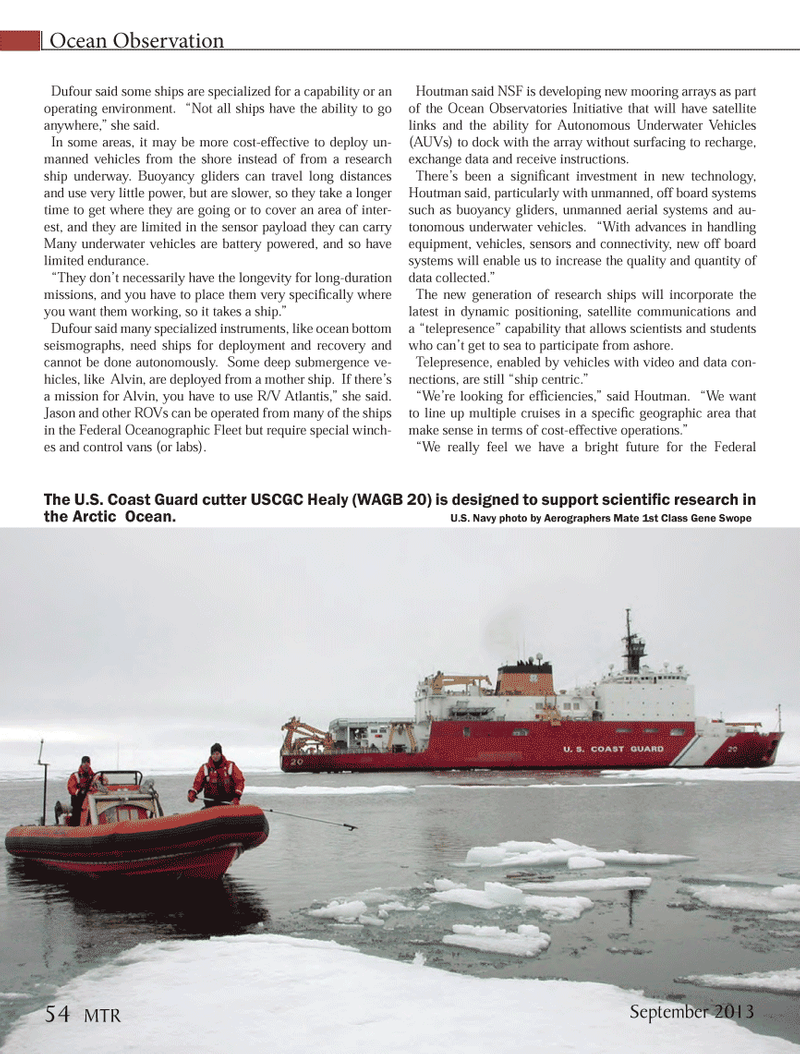
Page 54: of Marine Technology Magazine (September 2013)
Ocean Observation: Gliders, Buoys & Sub-Surface monitoring Networks
Read this page in Pdf, Flash or Html5 edition of September 2013 Marine Technology Magazine
Ocean Observation Dufour said some ships are specialized for a capability or an operating environment. ?Not all ships have the ability to go anywhere,? she said. In some areas, it may be more cost-effective to deploy un- manned vehicles from the shore instead of from a research ship underway. Buoyancy gliders can travel long distances and use very little power, but are slower, so they take a longer time to get where they are going or to cover an area of inter- est, and they are limited in the sensor payload they can carry Many underwater vehicles are battery powered, and so have limited endurance. ?They don?t necessarily have the longevity for long-duration missions, and you have to place them very speci cally where you want them working, so it takes a ship.? Dufour said many specialized instruments, like ocean bottom seismographs, need ships for deployment and recovery and cannot be done autonomously. Some deep submergence ve- hicles, like Alvin, are deployed from a mother ship. If there?s a mission for Alvin, you have to use R/V Atlantis,? she said. Jason and other ROVs can be operated from many of the ships in the Federal Oceanographic Fleet but require special winch- es and control vans (or labs). Houtman said NSF is developing new mooring arrays as part of the Ocean Observatories Initiative that will have satellite links and the ability for Autonomous Underwater Vehicles (AUVs) to dock with the array without surfacing to recharge, exchange data and receive instructions. There?s been a signi cant investment in new technology, Houtman said, particularly with unmanned, off board systems such as buoyancy gliders, unmanned aerial systems and au- tonomous underwater vehicles. ?With advances in handling equipment, vehicles, sensors and connectivity, new off board systems will enable us to increase the quality and quantity of data collected.? The new generation of research ships will incorporate the latest in dynamic positioning, satellite communications and a ?telepresence? capability that allows scientists and students who can?t get to sea to participate from ashore. Telepresence, enabled by vehicles with video and data con- nections, are still ?ship centric.? ?We?re looking for ef ciencies,? said Houtman. ?We want to line up multiple cruises in a speci c geographic area that make sense in terms of cost-effective operations.? ?We really feel we have a bright future for the Federal The U.S. Coast Guard cutter USCGC Healy (WAGB 20) is designed to support scienti Þ c research in the Arctic Ocean. U.S. Navy photo by Aerographers Mate 1st Class Gene Swope September 201354 MTRMTR #7 (50-65).indd 54MTR #7 (50-65).indd 548/22/2013 11:28:22 AM8/22/2013 11:28:22 AM

 53
53

 55
55
